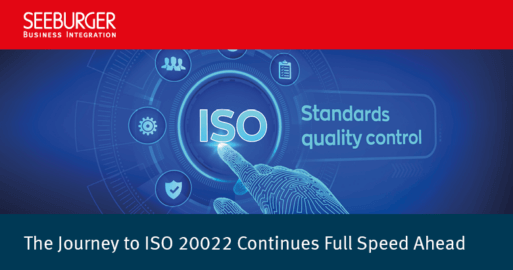ISO 20022 Payment Integration for Real-time Payments

The Migration to ISO 20022 Enters the Home Stretch
With the migration to ISO 20022 entering the home stretch, there’s no better time to get up to speed on this important topic. Here’s everything you need to know about the migration and why it matters.
ISO 20022 is so much more than changing message formats. ISO 20022 real-time payments enable banks and their customers to derive the benefits of open banking for payments across the IT landscape. ISO 20022 contains more data that can be integrated to provide a better 360 view of customer journeys, for example from bank-to-bank. If this valuable data is treated as such by integrating this information with other systems, this payment data can reduce risk and provide new revenue streams for banks. Integrating payments with KYC tools can reduce the risk of banking services exploitation and fraud, while supporting faster and even instant settlements and cash flow forecasting. Systems and services can be integrated to render valuable insights into customer activities, which are able to be productized and commoditized.
What is open banking?
Simply put, it’s providing customers with access to their account information and payments services, often using APIs to integrate backend systems. In Europe, PSD2 defines rules for how to achieve this to involve 3rd parties, and done correctly, banks are attracting more corporate customers by driving value through digital banking for real-time access to payments information and other customer-centric data.
Payment API Services
Key to a strategy of open banking, API services are used to opening up siloed systems, enabling data once stuck within certain banking functions to be shared among all integrated systems. Utilizing distributed ledger technology, is one key area which integration technology can support to generate a fully integrated payment integration landscape. An integration approach integrates payment systems, anti-money laundering technology, OFAC, KYC, FINtechnologies, and more.
Real-time Payments
The allure of real-time payments means that ISO 20022 is generating more payments, meaning there is an increased volume of files needing to be handled. At the same time, ISO files are composed of enriched data, which means the files themselves are also larger. Understanding the need to deal with larger transaction volumes and bigger files generates the need to ensure the technology is capable of handling this increased capacity. Simultaneously, to gain benefits from the enriched data, for example to adeptly understand customer activities and behaviors and reduce cash flow risks, payments must be integrated thoroughly in the banking landscape. Whether looking for the benefits of conforming to PSD2 or other payment initiatives, or how to implement an ISO 20022 messaging migration for example in accordance with SWIFT CGI-MP, banks are looking to empower customers through open banking initiatives. An ISO 20022 validator tool is a helpful piece of technology to ensure migration success. But fundamentally, driving value for end users, whether they are internal stakeholders in the form of corporate account managers or external stakeholders in the form of corporate customers, should be in the foreground of payments integration projects. Everyday situations can be resolved faster, for example the enablement of critical incident oversight. The right integration can provide answers instantly to the right people at the right time, allowing for an overview of where a payment landed or is stuck, how to speed up bulk payments, or whether to de-bulk and reassign payments to different queues. Ultimately, payments integration should enable the settlement process to be sped up as well. These are all strategic value drivers that provide tangible results for multiple stakeholder groups and concrete reasons to focus on the integration of the banking landscape in payments-related projects.
Open Banking Case Studies
There are a variety of open banking case studies from early adopters of payment integration and customer first initiatives. SEB, for example, explains how open banking initiatives reduced customer facing team response times, reduced customer representative workloads, increased customer experiences and their satisfaction, and in the end, increased their overall market share of corporate banking customers.
It is worth the effort to take advantage of modern payments, but these benefits are derived from a common data platform, master data management and the integration of legacy and disparate systems with a modernized approach for delivering business growth.
Benefits of Real-Time Payments and Open Banking
No longer just a ripple in the land of compliance requirements, ISO 20022 is an open banking initiative that is driving banks to enable payment network integration through all aspects of the banking infrastructure. Business leaders are looking for the strategic benefits that ISO 20022 can bring, whereas technical teams are looking for ISO 20022 validators tools, SWIFT ISO migration (SWIFT CGI), solutions for Fedwire®, Euro1, T2, psd2 gateways, MT102 AND MT 103 message conversion, and the like. Bringing the business teams and the technical teams together as a group for the evaluation of vendor solutions is key choosing payment integration software.
Using ISO 20022 as an instigator to create a modern payment integration hub can be a remarkable starting point for integrated open banking strategies. Seamlessly empower the users of your IT landscape with real-time cash balances, real-time forecasts, multibank views, and onboarding for ISO migration, while providing customers with real-time payments, and automated account transactions. Create a co-existence strategy for legacy payment formats and ISO 20022 and understand which API strategies can help modernize and consolidate your IT landscape.
From onboarding to reconciliation, the SEEBURER Payments Integration Hub enables real-time payments, empowers open banking and provides an agile core banking technology for future change.
To learn more, contact us or visit seeburger.com/solutions/fsi/.
Webcast On-Demand
Ready Or Not, Here It Comes
Find out how ready banks are for the migration to the new messaging format.
Watch nowThank you for your message
We appreciate your interest in SEEBURGER
Get in contact with us:
Please enter details about your project in the message section so we can direct your inquiry to the right consultant.
Written by: Rakesh Kukkamalla
Rakesh Kukkamalla, Enterprise Architect & VP Solution Engineering is responsible for leading design, development, and delivery of complex, high-performance, scalable integration solutions for SEEBURGER. Since joining SEEBURGER, he has been instrumental in the migration and consolidation of legacy integration solutions to hybrid integration platforms for several organizations in the financial services and insurance industries. His focus today is to help financial organizations in their payments modernization efforts with the adoption of ISO 20022. Rakesh’s expertise in MFT, B2B, APIs, and SEEBURGER’s Payments Integration Hub solutions is key to his work with customers across the globe. He has a bachelor’s degree in computer science from the National Institute of Technology and a master’s degree in computing studies from Arizona State University.





